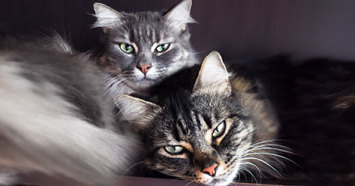
Clients have complained about this problem to me before but it was not one that I had the stress of dealing with myself. Unfortunately, it also falls in the category of “Practical Lessons I Wish I Would Have Heard of in Vet School.” Right up there with Dental Extractions 101 and absolutely anything on the business side of running a veterinary hospital. This complex topic is feline non-recognition aggression.
Imagine, or perhaps recall, a loving multi-cat household. Cats A and B are best friends and do everything together. Cat A goes to the vet and Cat B stays home. Cat A returns to receive anything but a warm welcome from Cat B, who hisses, attacks, and seems determined to destroy Cat A. Cat B is convinced Cat A is an enemy and a threat. A previously wonderful cat friendship seems a distant memory and the household is a tense environment for all humans and fur kids involved.
I learned this lesson from the University of Hard Knocks. We travel with our pets, like many people nowadays. Usually this works out well, but our calico cat, Mackenzie, became ill on a recent trip and we soon found ourselves in the vet emergency room at 1am. While Mackenzie suffered no long-term ill effects from the cup of espresso she managed to lap up while I was in the other room, the vacation condo was anything but relaxing when I returned home with Mackenzie the next morning.
Mackenzie was certainly bright-eyed and bushy-tailed, but it was not from her recent caffeine jolt. Rigby, our Siamese, greeted us at the door with anything but a warm welcome. There was hissing, fur flying, growling, and screaming. Initially, Mackenzie and I were frozen and shocked. As soon as I could compose myself, I realized that Rigby was experiencing what is called non-recognition feline aggression. She didn't know that Mackenzie was her best pal, as Mackenzie smelled like a complete stranger. It is believed that cats recognize one other from their scent, not visual clues.
Non-recognition aggression in cats is a bizarre phenomenon of events that remains largely hypothetical, but it does happen and the bad news is there is no easy fix. Non-recognition aggression occurs when one cat is uncharacteristically aggressive toward a companion cat after a period of separation.
Causes of Feline Non-Recognition Aggression
The returning cat has a new threatening smell, often picked up from other animals at an animal hospital.
The returning cat may have released his or her anal glands while away from home. While this discharge is simply a potent and stinky pet smell to us, it may signal fear and danger to your other cat.
Helping Your Cats Get Along
Separate the cats for as long it takes for the aggression to end. This may be a few hours or you may be unlucky like we were and it may take upwards of two weeks.
Bathe both cats.
You can try to counter condition the aggressor cat by offering food only when the other cat is in sight; even if they are on opposite sides of the room.
Keep the aggressor on a harness for the safety of all involved.
Whenever either cat shows any aggression, distract him/her by making a loud noise.
When you think things are beginning to improve, take very small steps. Rushing things will probably be counter-productive.
The chances that the cats' relationship, or at least tolerance of each other, can be reinstated are good, but my research has led me to discover that future meltdowns are likely once this sensitivity has been recognized. In other words, history is likely to repeat itself if steps are not taken to prevent recurrence. Useful measures to take include:
Make sure that a cat coming from the vet's office is fully recovered from sedation or anesthesia before returning home.
Bathe the returning cat to remove veterinary-type odors before returning him to the household.
After bathing, rub something with the cat's regular scent back on them, such as a blanket or toy.
Keep cats separate for a while after one returns from the vet's office until they re-familiarize with each other's sounds and odors.
As for me, I think both girls will be traveling to the vet together in the future. That experience was not one I ever want to repeat, and I'm sure both cats would agree.